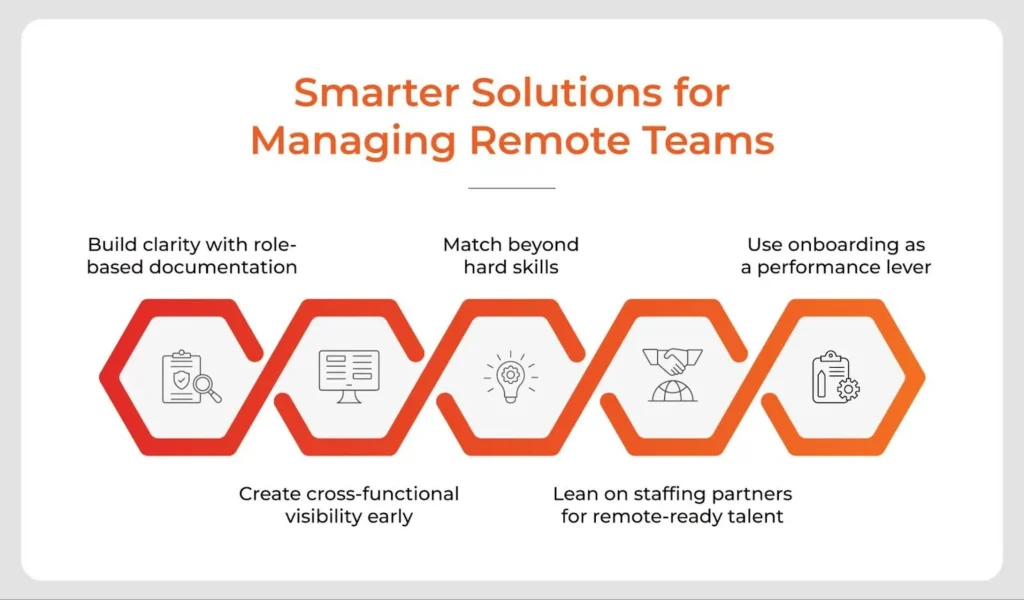Project staffing challenges are the obstacles companies face when trying to match the right talent to fast-moving, high-stakes projects. And with remote work becoming the norm, those challenges aren’t just logistical, but deeply strategic.
Remote work has changed the rules of project staffing. Sure, you’re no longer limited by geography, but that freedom comes with friction. For HR leaders and talent acquisition pros, the project staffing challenges in remote and distributed teams are more complex than ever.
You’re managing across time zones, juggling shifting priorities, and trying to keep everyone on the same page, all without a shared office or in-person check-ins. And in project-based roles where agility and execution speed are everything, these issues can derail progress fast.
So, what are today’s top staffing challenges? And more importantly, how are smart teams solving them with better project solutions?
Let’s break down what’s really going wrong and what forward-thinking teams are doing right.
What Are The Common Project Staffing Challenges?
Some issues are structural. Some others are operational. But most stem from the same core problem: you’re staffing for a moving target. Here are common project staffing challenges that often hinder progress:
1. Talent availability vs. project timelines
Project needs evolve fast, roles can open mid-sprint, and priorities shift without warning. While traditional hiring models offer structure and long-term alignment, they aren’t always designed for rapid pivots. Balancing availability with urgency thus becomes one of the biggest project staffing challenges.
2. Fragmented ownership
Take this scenario: Marketing kicks off a campaign that needs IT and customer support. But no one owns staffing, so the same IT lead gets pulled in from multiple directions, and deadlines start slipping.
Projects often span departments or even business units. Without clear staffing accountability, managers may rely on ad hoc assignments or shared internal resources, leading to burnout, bottlenecks, and blurred reporting lines.
3. Skill misalignment
Even when you fill a role quickly, the candidate might not have the exact skills or context the project needs. That mismatch can slow things down or cause issues later, often when deadlines are already tight.
4. Overlap and redundancy
In fast-moving teams, especially those spread across time zones, duplicate efforts often go unnoticed until deadlines loom. This comes down to unclear role design and a lack of staffing oversight.
Project Staffing Challenges Unique to Remote Teams
Remote work adds an entirely new layer of complexity to project staffing. Distributed models can drive flexibility but without the right systems, they can add to confusion. Below are staffing challenges that remote teams face:
1. Lack of coordination
The biggest challenge to managing a virtual project team is coordination. Timezone differences stretch working hours. Asynchronous collaboration slows decisions. And status updates get lost across messaging apps, emails, and endless video calls. What you save on office overhead, you lose in team alignment. It is thus important to work on team relationships while collaborating virtually.
2. Reduced visibility into performance and engagement
In co-located teams, managers can spot signs of disengagement or stress. In remote environments, the signals are subtle, and by the time you notice them, performance is already suffering.
3. Slower ramp-up times
Even with strong onboarding, new hires in remote teams face steeper learning curves. They’re less likely to absorb team norms quickly, making early-stage productivity and remote team management harder to achieve without deliberate intervention.
4. Cultural cohesion takes longer
Remote team management often leaves room for shared rituals or bonding opportunities. This affects communication quality, trust, and ultimately, speed of execution. This calls for dedicated efforts to boost team morale.
The good news? None of these is unsolvable

But they do require thoughtful structure, both in how you staff and how your team operates.
1. Build clarity with role-based documentation
In remote setups, misalignment can happen in the blink of an eye. Go beyond verbal briefings. Use tools like RACI charts, Notion, or Confluence to clearly define roles and responsibilities. Frameworks like DACI or team charters also help clarify ownership and reduce overlap.
2. Create cross-functional visibility early
Before assigning talent, clarify who owns what. Build a clear RACI (Responsible, Accountable, Consulted, Informed) model, not just for tasks, but for project staffing itself. Everyone should know who’s responsible for resourcing and tracking.
3. Match beyond hard skills
In remote teams, soft skills like working independently and communicating across time zones matter just as much as technical skills. Your staffing criteria should reflect that.
4. Use onboarding as a performance lever
Onboarding is an essential part of the hiring process, regardless of the recruitment model. However, for remote teams, investing early in a structured onboarding process becomes a crucial productivity strategy. Clear expectation setting and quickly connecting new hires to team norms, workflows, and informal knowledge help bridge the distance and accelerate their integration and effectiveness.
5. Lean on staffing partners for remote-ready talent
Companies like SPECTRAFORCE help organizations manage project team structures in distributed setups, delivering talent that’s pre-screened for both capability and virtual collaboration readiness. This drastically reduces ramp-up time and team friction.
Get Remote Project Staffing Right With These Best Practices
Even with the right talent, staffing for remote projects requires intentional systems. Here’s what separates high-performing distributed teams:
- Build remote-first project roles. Don’t copy-paste in-office roles. Build roles that work for remote setups. Plan for clear documentation, flexible hours, and working across time zones.
- Set shared goals and communication cadences. Align early on success metrics. Decide how and when updates happen and stick to it.
- Use collaborative staffing platforms. Centralized resource planning. Whether it’s a dedicated project staffing dashboard or integrated workforce planning tools, visibility reduces overlap and idle capacity.
- Regular check-ins, not just task updates. Use 1:1s or short retrospectives to keep a pulse on engagement and blockers, especially in time-bound projects.
- Prioritize psychological safety. Remote project teams function better when people feel safe raising flags, asking questions, or admitting confusion. Normalize that behavior.
Read more about building the right team, right in time, in our detailed blog about project staffing solutions.
Conclusion: Remote Doesn’t Have to Mean Disconnected
Yes, managing distributed teams brings new challenges. But the real risk isn’t remote work. It’s treating remote staffing like in-person staffing with a video-conferencing link.
The companies succeeding today are rethinking how roles are scoped, how performance is tracked, and how teams are assembled for speed and fit.
And they’re doing it with partners who understand project dynamics and remote realities.
At SPECTRAFORCE, we help clients build agile staffing models that adapt to demand and deliver talent that’s remote-ready from day one.
Need help managing project staffing challenges across your remote teams?
Contact us to learn how our project-based staffing services can support your team’s next phase of growth.
FAQs
Common staffing challenges for remote teams include time zone coordination, limited visibility into performance, delayed onboarding, and mismatched skillsets for remote work.
To manage seamless communication in remote project teams, it is important to establish clear cadences, use asynchronous-friendly tools (like Slack or Notion), and ensure shared expectations around response times and decision-making.
Yes, project staffing is effective in fully remote setups when staffed intentionally. Project-based staffing services help ensure skill fit, onboarding support, and flexibility in team scaling for remote environments.
Here are some ways in which you can ensure productivity in a remote project team:
1. Aligning on goals
2. Investing in onboarding
3. Checking in frequently
4. Establishing clarity in roles and workflows, especially in cross-functional teams.



